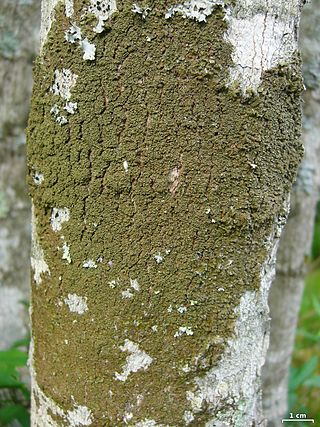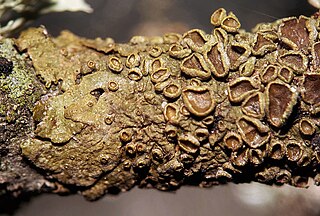
Parmelia is a genus of medium to large foliose lichens. It has a global distribution, extending from the Arctic to the Antarctic continent but concentrated in temperate regions. There are about 40 species in Parmelia. In recent decades, the once large genus Parmelia has been divided into a number of smaller genera according to thallus morphology and phylogenetic relatedness.

The Parmeliaceae is a large and diverse family of Lecanoromycetes. With over 2700 species in 71 genera, it is the largest family of lichen-forming fungi. The most speciose genera in the family are the well-known groups: Xanthoparmelia, Usnea, Parmotrema, and Hypotrachyna.

Masonhalea is a genus of two species of lichenized fungi in the family Parmeliaceae.

Hypogymnia is a genus of foliose lichens in the family Parmeliaceae. They are commonly known as tube lichens, bone lichens, or pillow lichens. Most species lack rhizines that are otherwise common in members of the Parmeliaceae, and have swollen lobes that are usually hollow. Other common characteristics are relatively small spores and the presence of physodic acid and related lichen products. The lichens usually grow on the bark and wood of coniferous trees.

Myelochroa is a genus of foliose lichens in the family Parmeliaceae. They are commonly known as axil-bristle lichens. It was created in 1987 to contain species formerly placed in genus Parmelina that had a yellow-orange medulla due to the presence of secalonic acids. Characteristics of the genus include tightly attached thalli with narrow lobes, cilia on the axils, and a rhizinate black lower surface. Chemical characteristics are the production of zeorin and related triterpenoids in the medulla. Myelochroa contains about 30 species, most of which grow on bark. The genus has centres of distribution in Asia and North America.

Melanohalea is a genus of foliose lichens in the family Parmeliaceae. It contains 30 mostly Northern Hemisphere species that grow on bark or on wood. The genus is characterized by the presence of pseudocyphellae, usually on warts or on the tips of isidia, a non-pored epicortex and a medulla containing depsidones or lacking secondary compounds. Melanohalea was circumscribed in 2004 as a segregate of the morphologically similar genus Melanelia.

Relicina is a genus of foliose lichens belonging to the large family Parmeliaceae. It contains 59 species.

Dactylina is a genus of lichen-forming fungi in the family Parmeliaceae. The genus was circumscribed by Finnish botanist William Nylander in 1860, with Dactylina arctica assigned as the type species.

Parmotrema rampoddense, commonly known as the long-whiskered ruffle lichen, is a species of foliose lichen in the family Parmeliaceae. It is widely distributed in tropical regions and grows on the bark of oak and palm trees.

Notoparmelia is a genus of foliose lichens in the family Parmeliaceae. It includes 18 species that grow on bark and rocks, and are mostly distributed in the Southern Hemisphere. The genus was created in 2014 as a segregate of Parmelia.
Bulbothrix meizospora is a species of foliose lichen in the family Parmeliaceae. It is found in Africa, Asia, and South America, where it grows on tree bark.

Melanohalea subolivacea, commonly known as the brown-eyed camouflage lichen, is a species of foliose lichen in the family Parmeliaceae.
Punctelia ulophylla is a species of foliose lichen in the family Parmeliaceae. It is found in Europe, where it grows on the bark of a variety of trees.

Punctelia perreticulata is a widely distributed species of foliose lichen in the family Parmeliaceae. It occurs in Mediterranean Europe and Russia, North America, South America, Australia, and New Zealand, where it grows on rocks, bark, or wood. Its main distinguishing features are its thallus surface, marked with many shallow depressions, grooves, or pits, and sorediate pseudocyphellae. The lower side of the thallus is ivory to tan towards the centre and the major secondary metabolite in the medulla is lecanoric acid. A lookalike species with which it has been historically confused is Punctelia subrudecta; this lichen can be distinguished from Punctelia perreticulata by the texture of the thallus surface, or, more reliably, by the length of its conidia.

Xanthoparmelia loxodes is a species of foliose lichen in the family Parmeliaceae. It was first formally described by Finnish botanist William Nylander in 1872, as Parmelia loxodes. In 1978, Ted Esslinger created the genus Neofuscelia, which contained species previously classified in Parmelia subgenus Neofusca; Neofuscelia loxodes was one of many species transferred here. In a 2004 molecular phylogenetic study published by Oscar Blanco, Ana Crespo, John A. Elix, David L. Hawksworth and H. Thorsten Lumbsch, they showed that Neofuscelia did not form a clade distinct from Xanthoparmelia, and they reduced it to synonymy under Xanthoparmelia.

Punctelia borreri is a species of foliose lichen in the family Parmeliaceae. It is a common and widely distributed species, occurring in tropical, subtropical, and temperate regions of Africa, Asia, Europe, North America, Oceania, and South America. The lichen typically grows on bark of deciduous trees, and less commonly on rock. Some European countries have reported increases in the geographic range or regional frequency of the lichen in recent decades, attributed alternatively to a reduction of atmospheric sulphur dioxide levels or an increase in temperatures resulting from climate change.
Parmelia ambra is a fossilised species of foliose lichen in the family Parmeliaceae. Found in Dominican amber and described as a new species in 2000, the fossil has been used in subsequent studies of lichen evolution.
Parmelia mayi is a species of foliose lichen in the family Parmeliaceae. It is found in the northern Appalachian Mountains of eastern North America, where it grows on rocks and on the trunks of paper birch and balsam fir. Parmelia mayi is morphologically indistinguishable from Parmelia saxatilis, but is distinct in its distribution, chemistry, and genetics.

Parmelia fraudans is a species of foliose lichen in the family Parmeliaceae. It is found in Europe and North America, where it grows on rocks.

Imshaugia aleurites, commonly known as the salted starburst lichen, is a species of foliose lichen in the family Parmeliaceae. It has a wide distribution in Europe and North America, and has also been recorded in China.















